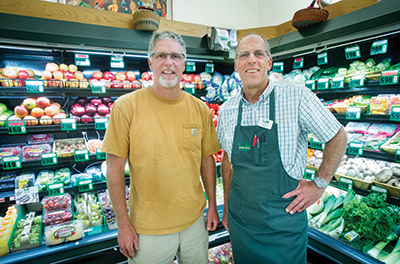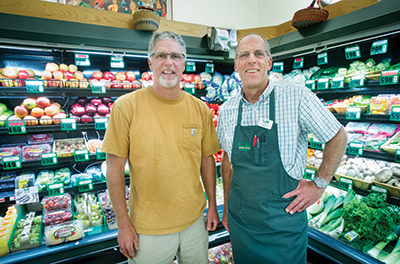
THE YEAR WAS 1929, the completion of the Golden Gate Bridge was eight years away and a young Frank Canepa, who worked at a grocery store in North Beach, took the Eureka ferry across the bay to visit a friend in Corte Madera. He took a wrong turn and wandered into Mill Valley, which reminded him of his home in Genoa, Italy.
Frank fell in love with the idyllic hamlet at the base of Mount Tamalpais and decided to open his own grocery store there. It wasn’t an easy start: the country was in an unprecedented depression, so in addition to running his store, he bartered for goods and services and extended credit to customers. Over the past 87 years Frank Canepa, followed by his sons Jim and Robert Canepa and, recently, Jim’s sons Dave and Doug Canepa, have run Mill Valley Market, a family business that has become integral to the community. The Canepas lived and raised their families in Mill Valley, sending their children to local schools and supporting the community through programs such as Shop & Give, which has donated almost $920,000 to local nonprofits since 1992 and co-hosting the annual Mill Valley Beer, Wine and Gourmet Food Festival. The brothers are well known not only as grocers but also as youth athletics coaches: Dave was a longtime girls’ basketball coach at Tamalpais High and Doug coaches Little League baseball.
What is the secret to success for a multigenerational family business?
Dave: This store is what it is today because of all the Canepas but primarily because of our father, Jim. He learned from his father, then put his entire life into the business. Then when Bob, his brother (younger by 15 years) and our uncle, got out of the service and came on board, he brought in new energy and ideas, as a young person. He brought the old people up to speed. Once Doug and I came along, we also had some new ideas and new energy. And now, the next generation, my son Ryan and Doug’s oldest, Eugene, are doing the same thing.
Did you both always know you would work in the family business?
Doug: We are old school. My father started working here when he was 10. We started working here when we were 10. It was just understood that we would work here. I can remember my first day here when I was in fifth grade and I’ve worked here ever since. We were raised in this store, just like my father and Bob.
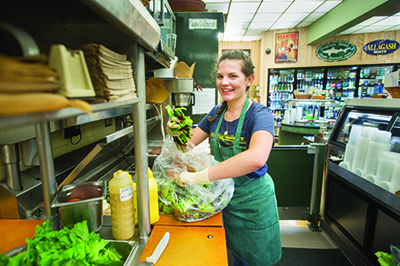
Have you ever considered expanding the business?
Dave: We have been asked many, many times to go look at other locations. And we have looked, but we have never had any thought of ever closing this location. Now, looking back, we realize that it is lucky that we never did take that step (of opening another store) because it would not have helped this location, and we never wanted to do anything to jeopardize this location.
Doug: We also thought, what is better than working and living in Mill Valley? Why would we ever want to go somewhere else and create more headaches when this is the best place to be?
How did the Mill Valley Beer, Wine and Gourmet Food Festival start?
Doug: The Book Depot was originally a train depot, and then it became a bus depot with a large parking lot, which is now the plaza. It was proposed that some of that parking lot get converted to a public space. The business community was concerned about giving up parking, so the city was thoughtful and involved the business community in the planning, and the plaza was opened in November 1981. To celebrate the opening my father organized a wine and gourmet food tasting. It was cold and raining, but people didn’t leave. They stood there in the rain tasting food and wine, and my father thought “I’m on to something,” so we moved the event to June. Now we partner with the Chamber of Commerce.
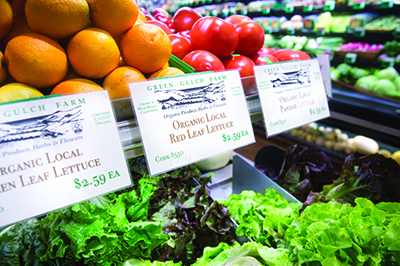
What are some of the food trends you have seen over the decades?
Doug: The 1970s saw growth in the California wine industry and we were instrumental in that. Food-wise in the ’60s, everyone was excited about buying Swanson’s TV dinners. Then, in the late ’60s and early ’70s, that was the beginning of the [American population’s] interest in gourmet food. It wasn’t so much organic, but my father was into fine foods, unique and esoteric foods, imported foods. That is when the Mill Valley Market changed from a grocery store to an upscale specialty market. He began traveling to Europe, to the food shows and began following food trends there. Then in the early ’90s, we started selling local and organic before it was cool, before Whole Foods. We reached out to small local growers, like Green Gulch Farms.
Dave: Craft beers! We were the first store in California to sell Henry Weinhard’s beer, in the early ’80s. In fact, Henry Weinhard’s made a national commercial about that.
Tell me about some of your local purveyors.
Doug: We have worked with Green Gulch since the early ’90s. And Stan Devoto in Sebastopol, who grows apples. Parkside Bread, from Stinson, is outstanding bread. There are many. Because of what are called “slotting fees” at big stores, it is very difficult for a small producer to reach market going the chain route, so we are an outlet for these interesting producers.
Dave: We have Mill Valley local honey, local eggs, even eggs from my own chickens and honey from my own bees. One of our newest producers is a student at Drake High School who is making jams.
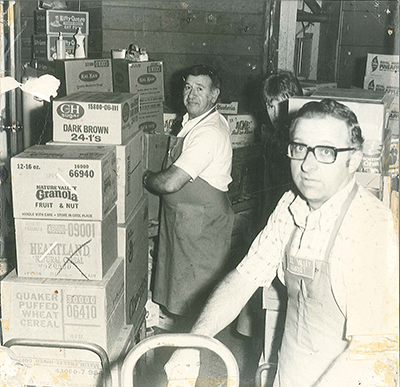
What would your grandfather Frank Canepa think if he saw the market now?
Doug: I think he’d be happy because his grandchildren are running it, and his great-grandchildren will be instrumental here soon. I think of us as caretakers for this institution. If Mill Valley is good to us, we need to be good to Mill Valley. As a caretaker, I have a responsibility to keep this business thriving and forward-thinking and providing the things that the people of Mill Valley want. That is what I want to teach my son and my nephew.
When you bring in people from the next generation, where do they usually start?
Dave: One rule is the kids need to be tall enough to reach into the shopping carts before they can start bagging. And then they can pick up more responsibilities as they get older, can work in the deli or meat department, and once they are 18, they can start running the cash registers. We may all have other responsibilities now but we still end up bagging groceries and cleaning up every day.
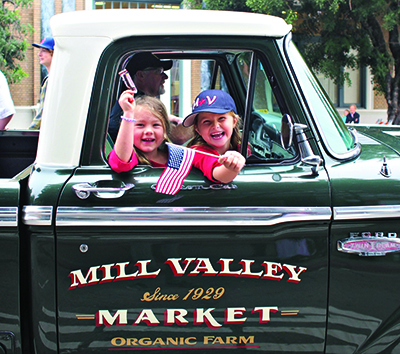
How are you with social media? Do you tweet your specials? Or Instagram the fresh produce?
Doug: David and I are Luddites — we are an old-fashioned store. However, thankfully Ryan is familiar with this important aspect of today’s life. We have Facebook and Instagram and post farm developments, community things like Little League teams, our old truck in a parade, or other interesting things. We try and share stuff when we think about it, but really we should do more. It’s just hard to find time to do Twitter, Instagram, Facebook, etc., and still try and run a grocery store.
What are the biggest changes you have seen as businesspeople in the last 80 years?
Doug: The globalization of commerce — we are competing with everyone local and afar and product knowledge is at everyone’s fingertips with the Internet. Because of the increased interest in global cuisine, the requested items have definitely become much more specialized. About once a month I will get a series of four to five requests for the same strange product that no one had ever asked for before — things like za’atar seasoning, green tea noodles, or whatever the new hip ancient grain is.
This article originally appeared in Marin Magazine’s print edition with the headline: “Doug and David Canepa”.
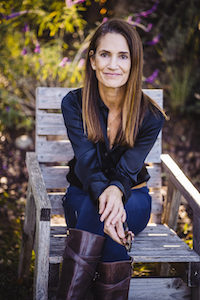
Kirsten Jones Neff is a journalist who writes about all things North Bay, with special attention to the environment and the region’s farmers, winemakers and food artisans. She also works and teaches in school gardens. Kirsten’s poetry collection, When The House Is Quiet, was nominated for the Northern California Book Award, and three of her poems received a Pushcart nomination. She lives in Novato with her husband and three children and tries to spend as much time as possible on our local mountains, beaches and waterways. For more on her work visit KirstenJonesNeff.Com.

